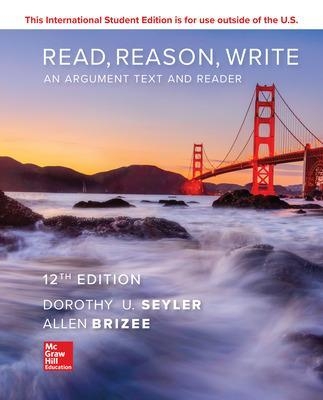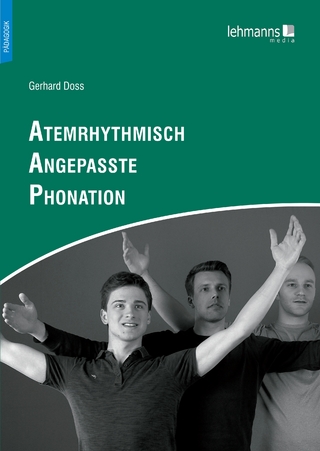
ISE Read, Reason, Write
McGraw-Hill Education (Verlag)
978-1-260-09163-2 (ISBN)
- Titel z.Zt. nicht lieferbar
- Versandkostenfrei innerhalb Deutschlands
- Auch auf Rechnung
- Verfügbarkeit in der Filiale vor Ort prüfen
- Artikel merken
Dorothy Seyler holds advanced degrees from Columbia University and the State University of New York at Albany and is a Phi Beta Kappa graduate of the College of William and Mary. Dr. Seyler is professor emerita of English at Northern Virginia Community College and has taught at Ohio State University, the University of Kentucky, and Nassau Community College. In addition to articles published in both scholarly journals and popular magazines, Dr. Seyler is the author of 10 college textbooks, including Introduction to Literature, Doing Research, Steps to College Reading, and Patterns of Reflection. Read, Reason, Write was first published in 1984. In 2007, Dr. Seyler was elected to membership in the Cosmos Club in Washington, D.C., for excellence in education.
CONTENTS
New to the 12th Edition
Features of Read, Reason, Write
Let Connect Composition Help Your Students Achieve Their Goals
Let the Customizable Resources of Create Help You
About the Authors
From the Authors
SECTION 1 CRITICAL READING AND ANALYSIS
Chapter 1 Writers and Their Sources
Reading, Writing, and the Contexts of Argument
Responding to Sources
Abraham Lincoln, “The Gettysburg Address”
The Response to Content
The Analytic Response
The Evaluation Response
The Research Response
Deborah Tannen, “Who Does the Talking Here?”
Writing Summaries
Guidelines for Writing Summaries
Active Reading: Use Your Mind!
Guidelines for Active Reading
Ruth Whippman, “Actually, Let’s Not Be in the Moment”
Using Paraphrase
Acknowledging Sources Informally
Referring to People and Sources
Joel Achenbach, “The Future Is Now: It’s Heading Right At Us, But We Never
See It Coming”
Presenting Direct Quotations: A Guide to Form and Style
Reasons for Using Quotation Marks
A Brief Guide to Quoting
For Reading and Analysis
Alex Knapp, “Five Leadership Lessons from James T. Kirk”
Suggestions for Discussion and Writing
Chapter 2 Responding Critically to Sources
Traits of the Critical Reader/Thinker
Examining the Rhetorical Context of a Source
Who Is the Author?
What Type—or Genre—of Source Is It?
What Kind of Audience Does the Author Anticipate?
What is the Author’s Primary Purpose?
What Are the Author’s Sources of Information?
Analyzing the Style of a Source
Denotative and Connotative Word Choice
Tone
Level of Diction
Sentence Structure
Metaphors
Organization and Examples
Repetition
Hyperbole, Understatement, and Irony
Quotation Marks, Italics, and Capital Letters
Alexandra Petri, “Nasty Women Have Much Work to Do”
Writing about Style
Understanding Purpose and Audience
Planning the Essay
Drafting the Style Analysis
A Checklist for Revision
Ellen Goodman, “In Praise of a Snail’s Pace”
Student Essay: James, Goode, “A Convincing Style”
Analyzing Two or More Sources
Guidelines for Preparing a Contrast Essay
For Reading and Analysis
Adam Grant, “Why I Taught Myself to Procrastinate”
Suggestions for Discussion and Writing
SECTION 2 THE WORLD OF ARGUMENT
Chapter 3 Understanding the Basics of Argument
Characteristics of Argument
Argument Is Conversation with a Goal
Argument Takes a Stand on an Arguable Issue
Argument Uses Reasons and Evidence
Argument Incorporates Values
Argument Recognizes the Topic’s Complexity
The Shape of Argument: What We Can Learn from Aristotle
Ethos (about the Writer/Speaker)
Logos (about the Logic of the Argument)
Pathos (about Appeals to the Audience)
Kairos (about the Occasion or Situation)
The Language of Argument
Facts
Inferences
Judgments
Sam Wang and Sandra Aamodt, “Your Brain Lies to You”
The Shape of Argument: What We Can Learn from Toulmin
Claims
Grounds (or Data or Evidence)
Warrants
Backing
Qualifiers
Rebuttals
Using Toulmin’s Terms to Analyze Arguments
Erin Brodwin, “The Secret to Efficient Teamwork Is Ridiculously Simple”
For Analysis and Debate
Christina Paxson, “A Safe Space for Freedom of Expression”
Geoffrey R. Stone, “Free Speech on Campus”
Suggestions for Discussion and Writing
Chapter 4 Writing Effective Arguments
Know Your Audience
Who Is My Audience?
What Will My Audience Know about My Topic?
Where Does My Audience Stand on the Issue?
How Should I Speak to My Audience?
Understanding Your Writing Purpose
What Type (Genre) of Argument Am I Preparing?
What Is My Goal?
Will the Rogerian or Conciliatory Approach Work for Me?
Move from Topic to Claim to Possible Support
Selecting a Topic
Drafting a Claim
Listing Possible Grounds
Listing Grounds for the Other Side or Another Perspective
Planning Your Approach
Draft Your Argument
Guidelines for Drafting
Revise Your Draft
Rewriting
Editing
A Few Words about Words and Tone
Proofreading
A Checklist for Revision
For Analysis and Debate
Darius Rejali, “Five Myths about Torture and Truth”
Gregg Bloche, “Torture Is Wrong—But It Might Work”
Suggestions for Discussion and Writing
Chapter 5 Reading, Analyzing, and Using Visuals and Statistics in Argument
Responding to Visual Arguments
Visual Rhetoric and Visual Literacy
Guidelines for Reading Photographs
Guidelines for Reading Political Cartoons
Guidelines for Reading Advertisements
Reading Graphics
Understanding How Graphics Differ
Guidelines for Reading Graphics
The Uses of Authority and Statistics
Judging Authorities
Understanding and Evaluating Statistics
&nb
sp; Guidelines for Evaluating Statistics
Writing the Investigative Argument
Gathering and Analyzing Evidence
Planning and Drafting the Essay
Guidelines for Writing an Investigative Argument
Analyzing Evidence: The Key to an Effective Argument
Preparing Graphic for Your Essay
A Checklist for Re
| Erscheinungsdatum | 20.09.2018 |
|---|---|
| Verlagsort | OH |
| Sprache | englisch |
| Maße | 191 x 231 mm |
| Gewicht | 787 g |
| Themenwelt | Schulbuch / Wörterbuch ► Wörterbuch / Fremdsprachen |
| Geisteswissenschaften ► Sprach- / Literaturwissenschaft ► Sprachwissenschaft | |
| ISBN-10 | 1-260-09163-5 / 1260091635 |
| ISBN-13 | 978-1-260-09163-2 / 9781260091632 |
| Zustand | Neuware |
| Haben Sie eine Frage zum Produkt? |
aus dem Bereich


